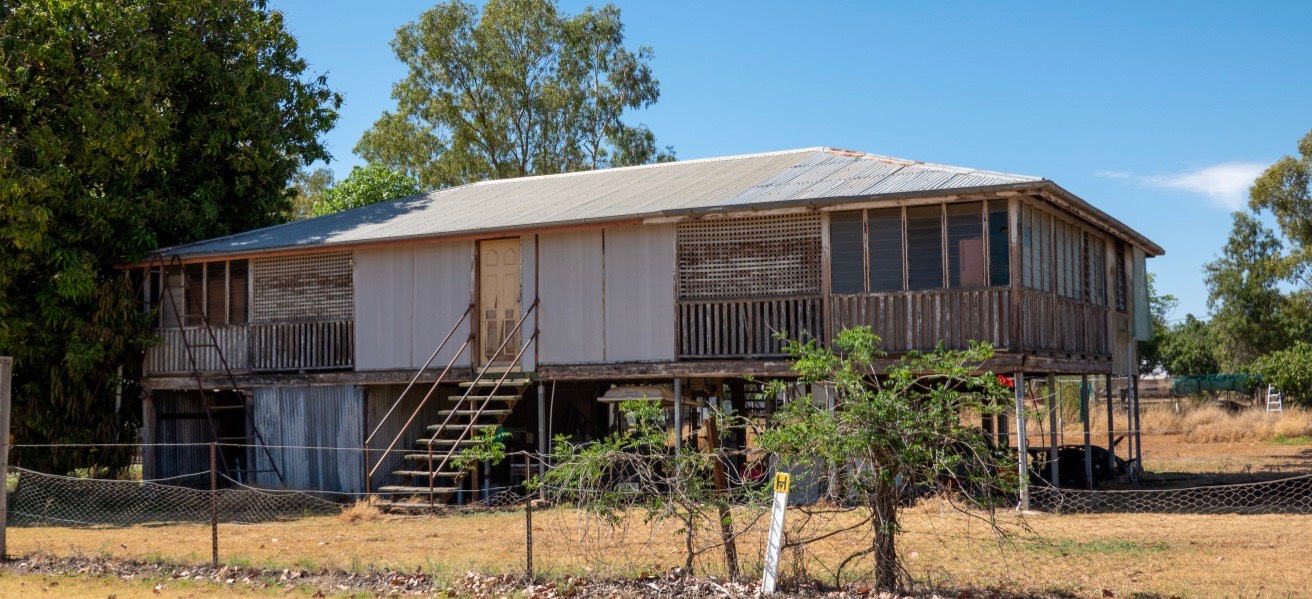 From Winton the highway runs parallel to the old railway line connecting the outback with the coast. In the early 20th century it finished at Longreach. That is also why in 1920 the founders of Qantas chose Longreach as a base for their innovative Queensland and Northern Territory Airline.
From Winton the highway runs parallel to the old railway line connecting the outback with the coast. In the early 20th century it finished at Longreach. That is also why in 1920 the founders of Qantas chose Longreach as a base for their innovative Queensland and Northern Territory Airline.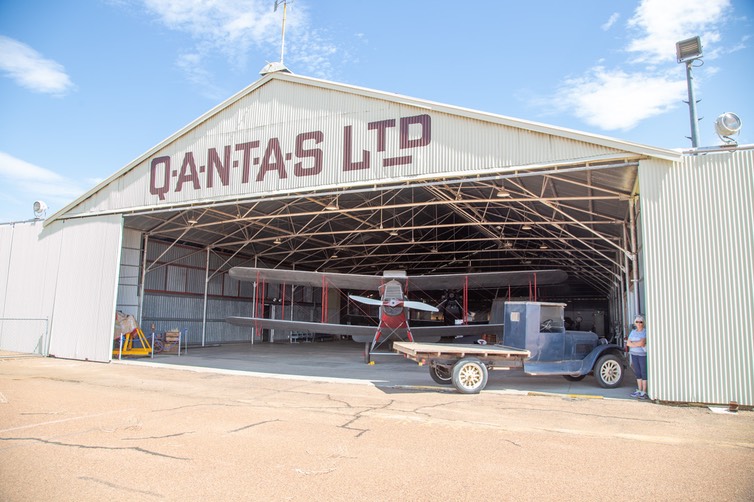 Initially, before evolving to Australia's National Airline, their small planes only offered a mail and ambulance service .
Initially, before evolving to Australia's National Airline, their small planes only offered a mail and ambulance service .
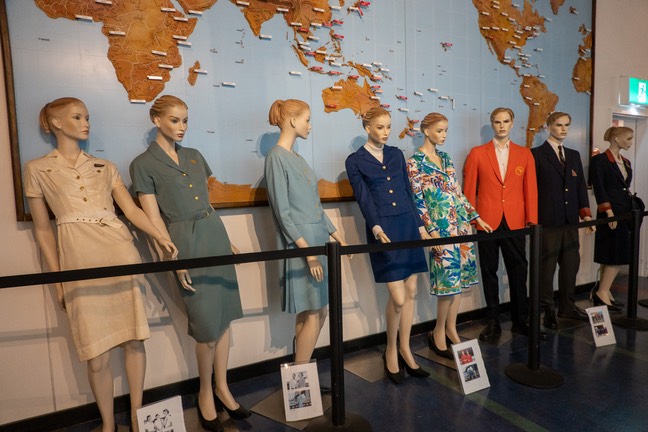 When we visited the Qantas Founders Museum, work was in full “flight” (so to speak) to prepare for the airlines 100th birthday next year. It is quite amazing to hear of the humble beginnings of Qantas which came into existence through the imagination, tenacity and chance encounters of men like Fysh, Mc Guinness and McMasters!
When we visited the Qantas Founders Museum, work was in full “flight” (so to speak) to prepare for the airlines 100th birthday next year. It is quite amazing to hear of the humble beginnings of Qantas which came into existence through the imagination, tenacity and chance encounters of men like Fysh, Mc Guinness and McMasters!
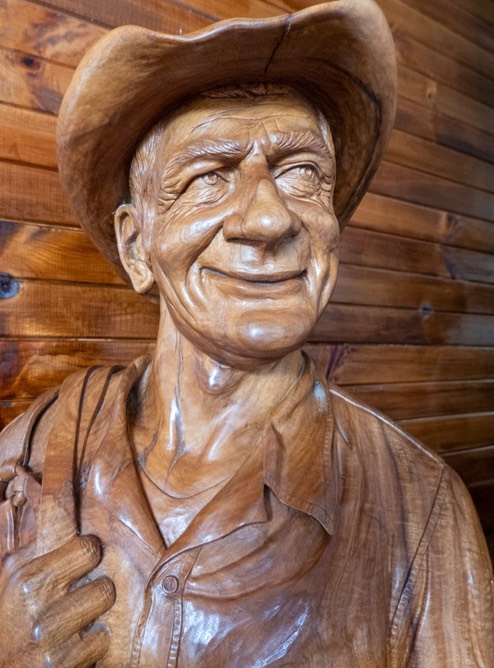 Another example of Aussie tenacity is shown in the Stockman's Hall of Fame. This museum is absolutely fascinating! It’s full of memorabilia and individual stories of stockmen and -women their history being an essential part of what this country was built on. From the pioneers clearing the land by hand in the harshest of environments to acquiring all the skills in mastering large herds of sheep and cattle on horseback, these men and women deserved more than a medal! I especially liked to read about the women who looked after everything on the station while the men were often gone for weeks at a time.
Another example of Aussie tenacity is shown in the Stockman's Hall of Fame. This museum is absolutely fascinating! It’s full of memorabilia and individual stories of stockmen and -women their history being an essential part of what this country was built on. From the pioneers clearing the land by hand in the harshest of environments to acquiring all the skills in mastering large herds of sheep and cattle on horseback, these men and women deserved more than a medal! I especially liked to read about the women who looked after everything on the station while the men were often gone for weeks at a time.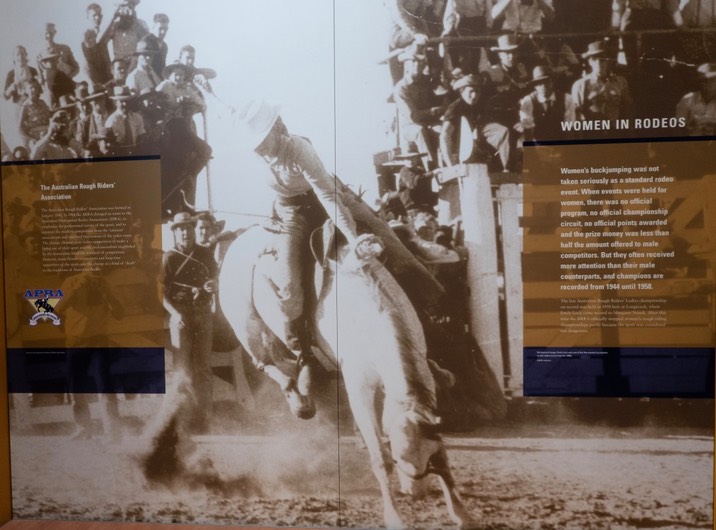 But later they also developed great skills in managing stock and horses, many becoming stock-women themselves. During WWI the aboriginal stockmen were more and more relied on. Their knowledge of the land and ability to endure in the most challenging conditions was a great asset. The seasonal work also suited their culture and allowed them to attend traditional ceremonies.
But later they also developed great skills in managing stock and horses, many becoming stock-women themselves. During WWI the aboriginal stockmen were more and more relied on. Their knowledge of the land and ability to endure in the most challenging conditions was a great asset. The seasonal work also suited their culture and allowed them to attend traditional ceremonies.
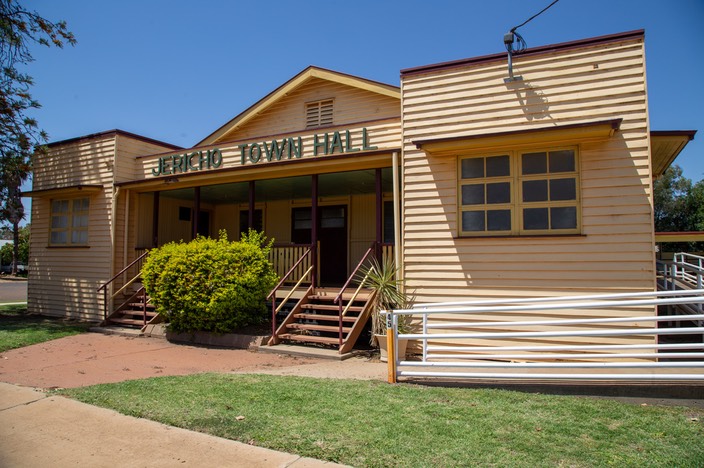
Following the Landsborough Highway eastwards, we came through Barcaldine where another important part of Australia's history played out. An amazing artwork called the "Tree of Knowledge”, erected around the trunk of a ghost gum, celebrates the birth of the labour movement in Australia. 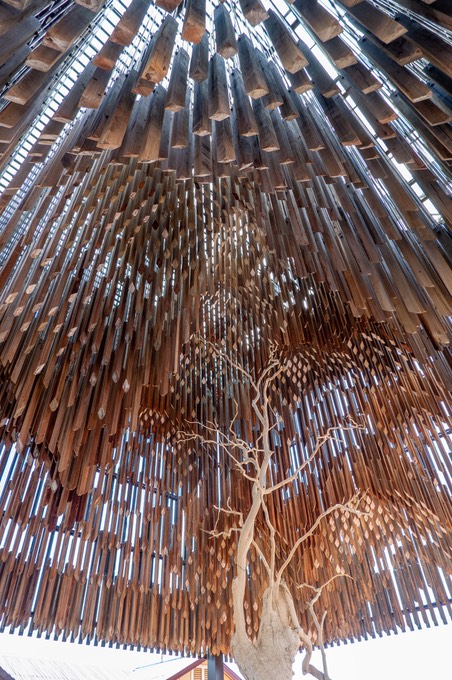 Within the timber frame wooden stakes of diverse length give the impression of a canopy and emit xylophone like sounds when moved together by the breeze. Nearby 13 post commemorate the 13 jailed union leaders of the shearers strike in the late 19th century.
Within the timber frame wooden stakes of diverse length give the impression of a canopy and emit xylophone like sounds when moved together by the breeze. Nearby 13 post commemorate the 13 jailed union leaders of the shearers strike in the late 19th century.
Further along the highway, at the Jordan River and south of Lake Galilee, is the township of Jericho. By the way, we are still in Australia! I think the names originated from a pioneer called Harry Jordan and followed on from there. A group of local artist have created a modern artwork of the bible story of Joshua and the walls of Jericho, called “The Crystal Trumpeters”.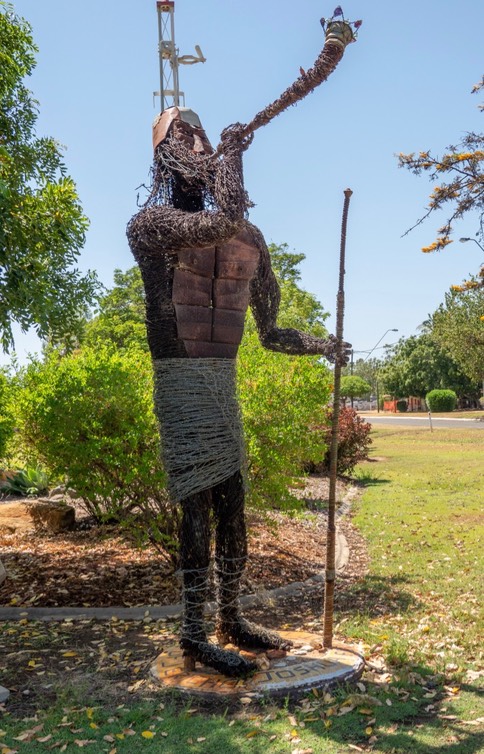 A single trumpeter stands proudly at the town centre which consists of a combined post office/shop/tourist bureau and a pub, all closed on this Friday afternoon. We had our own chance encounter when a couple from Mackay pulled up with their van, desperately looking to buy a cup of coffee. It turned out, that the gentleman is the brother of an Australian we met 42 years ago on a camping ground in Rome, where Austin and I found each other!
A single trumpeter stands proudly at the town centre which consists of a combined post office/shop/tourist bureau and a pub, all closed on this Friday afternoon. We had our own chance encounter when a couple from Mackay pulled up with their van, desperately looking to buy a cup of coffee. It turned out, that the gentleman is the brother of an Australian we met 42 years ago on a camping ground in Rome, where Austin and I found each other!
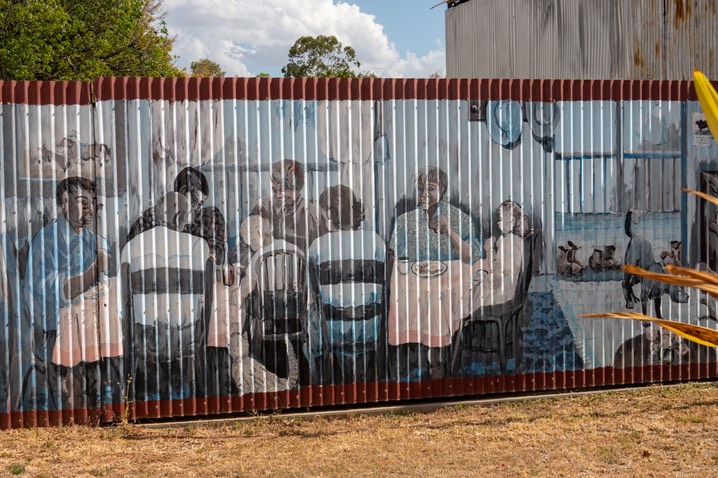 Then two years later, during our trip around Australia, we visited the Australian on his family's sugar cane farm, where the brother and his wife we met in Jericho are still living today!
Then two years later, during our trip around Australia, we visited the Australian on his family's sugar cane farm, where the brother and his wife we met in Jericho are still living today!
We were still shaking our heads in disbelief when we reach Alpha, the former coal mining and cattle town. While I was admiring one of Alphas 28 murals, Austin had been in deep conversation with Nola, an octogenarian volunteer manning the visitors office and old station house. There was not much Nola didn’t know about the towns history. 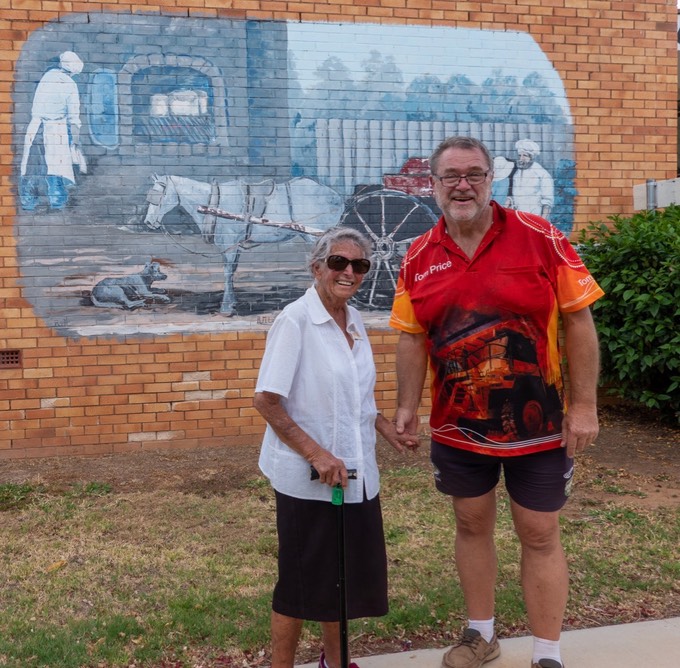 From her we learned that the name “Alpha” could have been coined by Major Thomas Mitchell who surveyed this area before it became one of the richest cattle raising regions in the state of Queensland. The streets all bear the names of great poets like Shakespeare, Byron, and Lawson Street. Alpha is rich in petrified wood findings dating back approximately 290 million years, and Nola is a passionate collector of fossils.
From her we learned that the name “Alpha” could have been coined by Major Thomas Mitchell who surveyed this area before it became one of the richest cattle raising regions in the state of Queensland. The streets all bear the names of great poets like Shakespeare, Byron, and Lawson Street. Alpha is rich in petrified wood findings dating back approximately 290 million years, and Nola is a passionate collector of fossils. 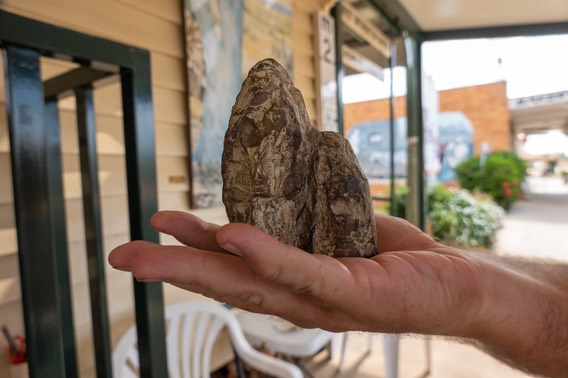 One of the fossils Austin picked up was apparently a piece of fossilised dinosaur faeces, known as Coprolite! What a thrill!!! In Shakespeare Street a modern sculpture “The Fossilised Forest” represents the areas prehistoric past and nature reaching into the present and future. We liked this charming outback town and stayed overnight under trees full of colourful rainbow lorikeets, pale faced corellas and blue faced honey eaters. Unfortunately we didn’t find a "Major Mitchell Cockatoo”!
One of the fossils Austin picked up was apparently a piece of fossilised dinosaur faeces, known as Coprolite! What a thrill!!! In Shakespeare Street a modern sculpture “The Fossilised Forest” represents the areas prehistoric past and nature reaching into the present and future. We liked this charming outback town and stayed overnight under trees full of colourful rainbow lorikeets, pale faced corellas and blue faced honey eaters. Unfortunately we didn’t find a "Major Mitchell Cockatoo”!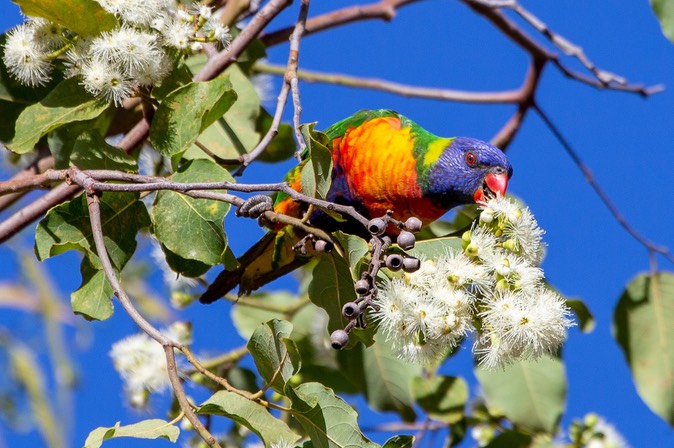
From Alpha the Capricorn Highway climbs up to the Central Highland which is part of the Great Dividing Range. It then runs through the gem fields and into Emerald where we hoped to get our car problems checked again. 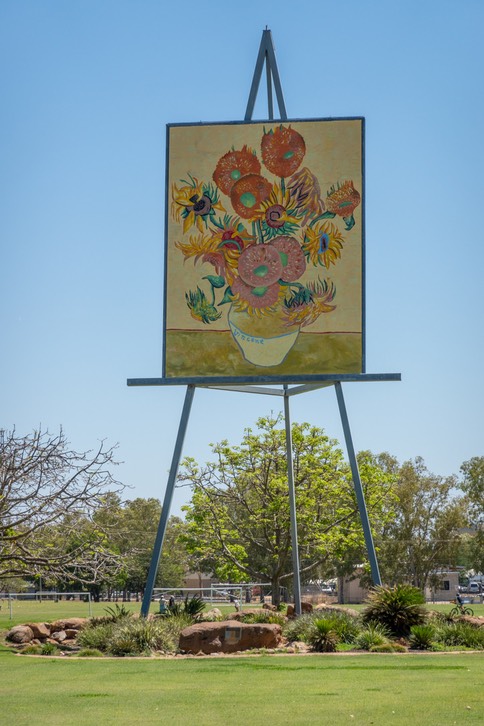 There has been a palpable climate change with greater humidity and lower temperatures, now only reaching the mid thirties. In spite of its vicinity to the gem fields Emerald was named after its green pastures, not the precious stone. The town used to pride itself on its sunflower production shown by a big easel with van Gogh’s Sunflowers standing in Morton Park.
There has been a palpable climate change with greater humidity and lower temperatures, now only reaching the mid thirties. In spite of its vicinity to the gem fields Emerald was named after its green pastures, not the precious stone. The town used to pride itself on its sunflower production shown by a big easel with van Gogh’s Sunflowers standing in Morton Park.
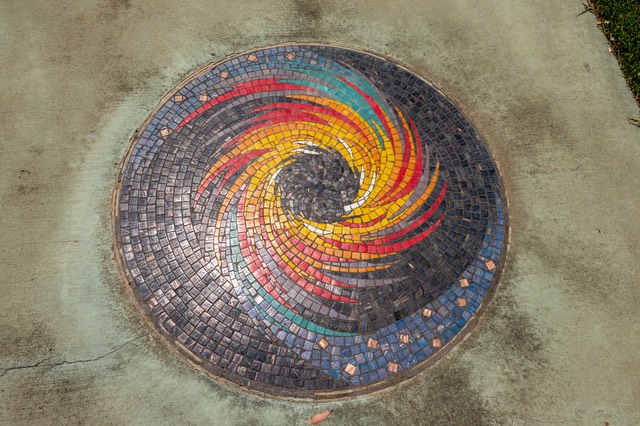 A pathway adorned with colourful mosaic pictures leads up to it. In front of town hall is a great example of a petrified tree said to be 295 million years old and so preceding the dinosaur bones we have seen in Winton. So in the scheme of things - we are all very, very young indeed!
A pathway adorned with colourful mosaic pictures leads up to it. In front of town hall is a great example of a petrified tree said to be 295 million years old and so preceding the dinosaur bones we have seen in Winton. So in the scheme of things - we are all very, very young indeed!